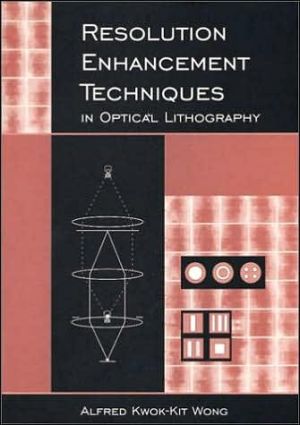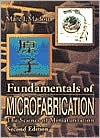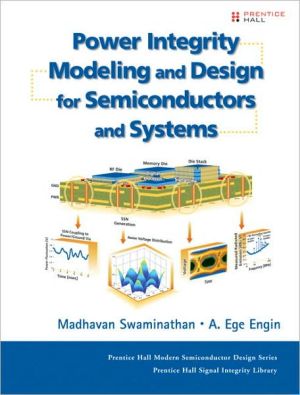Resolution Enhancement Techniques in Optical Lithography
This tutorial summarizes optical lithography enhancement research and development over the past 20 years. Discusses theoretical and practical aspects of commonly used techniques, including optical imaging and resolution, modified illumination, optical proximity correction, alternating and attenuating phase-shifting masks, selecting RETs, and second-generation RETs. Useful for students and practicing lithographers.
Search in google:
This tutorial summarizes optical lithography enhancement research and development over the past 20 years. Discusses theoretical and practical aspects of commonly used techniques, including optical imaging and resolution, modified illumination, optical proximity correction, alternating and attenuating phase-shifting masks, selecting RETs, and second-generation RETs. Useful for students and practicing lithographers. Booknews The acceleration of integrated circuit miniaturization is challenging lithographers to push the limits of optical lithography by ever more precise engineering and innovation. As shrinkage of integrated circuit device dimension outpaces introduction of shorter-exposure wavelengths and higher-numerical-aperture lenses, resolution enhancement techniques are becoming essential in optical lithography. This work attempts to summarize the advances in the field over the past two decades, concentrating on both theory and practice. Annotation c. Book News, Inc., Portland, OR (booknews.com)
PrefacexiiiList of symbolsxvList of abbreviationsxvii1Introduction11.1Brief history of printing and lithography11.2Optical lithography and integrated circuits21.3Basics of optical lithography61.3.1Illumination61.3.2Reticle81.3.3Exposure131.3.4Photoresist181.3.5Optical lithography system parameters231.4Requirements of microlithography241.5Nonoptical microlithography techniques261.6Current challenges of optical microlithography271.7Three parameters affecting resolution281.8Scope of discussion302Optical Imaging and Resolution312.1Coherent imaging312.1.1Principle312.1.2Resolution342.2Mask spectrum392.2.1Pitch dependence422.2.2Dependence on dimension422.2.3Two-dimensional patterns442.3Partially coherent imaging452.4Complex degree of coherence552.5Rayleigh's resolution limit582.6Lithography resolution limit592.7Quantification of image quality592.7.1Modulation transfer function602.7.2Contrast602.7.3Exposure latitude602.7.4Normalized image log slope612.7.5Depth of focus622.7.6Exposure-defocus window642.7.7Total window662.7.8Common window682.7.9Linewidth variability693Modified Illumination713.1Partial coherence factor713.1.1Large [sigma]713.1.2Small [sigma]793.1.3Medium [sigma]793.2Off-axis illumination803.2.1Dipole803.2.2Quadrupole843.2.3Annular853.2.4Implementation issues873.3General guidelines904Optical Proximity Correction914.1Image distortion914.2Optical proximity correction approaches924.2.1Catastrophic OPC934.2.2Linewidth variation minimization944.2.3Line shortening1004.2.4Corner rounding1004.3Numerical techniques1014.3.1Rule-based1024.3.2Model-based1034.3.3Hybrid1054.4Implementation1064.4.1Correction function derivation1064.4.2CAD system1104.5Discussion1155Alternating Phase-Shifting Mask1175.1Principle1175.2Mask-making process1215.3Issues1235.3.1Intensity imbalance1235.3.2Aberration sensitivity1265.3.3Mask defect1285.4Implementation1305.4.1Dark-field application1315.4.2Light-field application1335.5Summary1386Attenuated Phase-Shifting Mask1396.1Principle1396.2Mask making1476.2.1Thin film1476.2.2Opaque border1486.3Discussion1517Selecting Appropriate RETs1537.1Critical levels1537.2Methodology1547.2.1Include applicable approaches1547.2.2Select promising techniques1557.2.3Experimental quantification1587.3Optimization results1587.3.1Storage1607.3.2Isolation1637.3.3Word line1647.3.4Bit line contact1667.4Summary and discussion1688Second-Generation RETs1718.1Multiple exposure1718.1.1Forming sharp corners1728.1.2Assembling patterns1728.2Pupil filtering1758.3Advanced illumination scheme1768.3.1Concurrent reticle-illumination optimization1768.3.2Dark-field illumination1778.4Compensating process1808.5Mask and photoresist tone180Concluding Remarks183k[subscript 1] Conversion Charts187Bibliography189Index209
\ BooknewsThe acceleration of integrated circuit miniaturization is challenging lithographers to push the limits of optical lithography by ever more precise engineering and innovation. As shrinkage of integrated circuit device dimension outpaces introduction of shorter-exposure wavelengths and higher-numerical-aperture lenses, resolution enhancement techniques are becoming essential in optical lithography. This work attempts to summarize the advances in the field over the past two decades, concentrating on both theory and practice. Annotation c. Book News, Inc., Portland, OR (booknews.com)\ \








